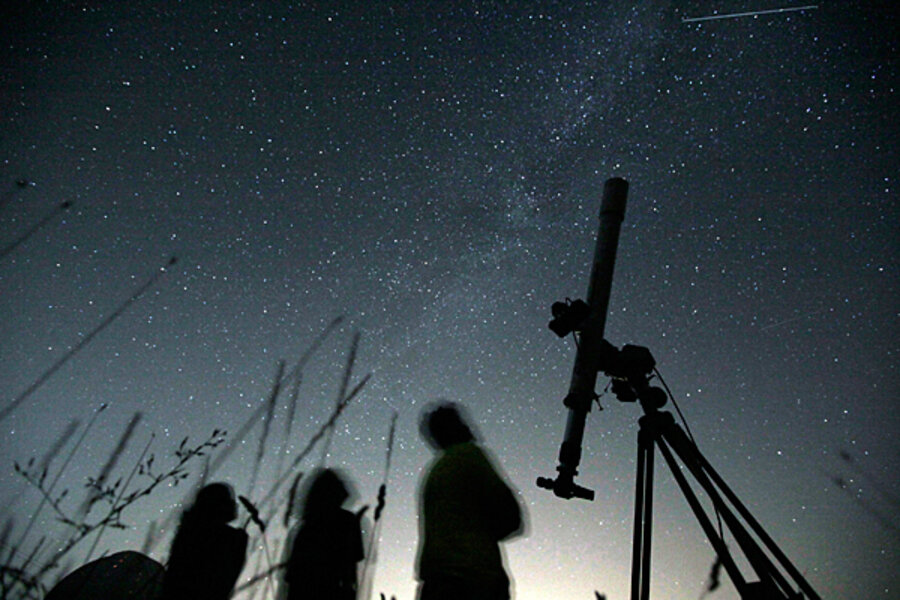Perseid meteor shower tonight: It's a spectacular troublemaker
Loading...
The Perseid meteor shower tonight, which peaks during the early hours of Friday morning, is widely regarded as perhaps the most consistently spectacular meteor shower of the year.
But it also is the only meteor shower known to have killed a satellite and delayed a space-shuttle launch. And as recently as last year, it may have knocked the Landsat 5 Earth-observing satellite off its rocker temporarily.
Enter Bill Cooke, who heads the National Aeronautics and Space Administration's Meteoroid Environment Office at the Marshall Space Flight Center in Huntsville, Ala. His small shop is the meteor-shower equivalent to the National Hurricane Center in Miami.
"My office is pretty much focused on meteor risk, to spacecraft in particular," Dr. Cooke says. It's responsible for predicting when a shower will take place, how intense it's likely to be, and what sort of threat it may pose to manned and unmanned spacecraft.
The effort owes its existence to the Columbia disaster in February 2003. Seven astronauts died as the shuttle Columbia broke up during reentry after a trip to the International Space Station. The cause: Ice fell away from the orbiter's main fuel tank during the shuttle's ascent, damaging the heat-shielding material on the leading edge of one of the orbiter's wings.
The tragedy refocused NASA's attention on debris hazards of all types, including meteoroid strikes. Meteoroids are the tiny and not-so-tiny bits of naturally occurring space dust and rock that undergo a couple of name changes before they hit the ground. They are meteors as they streak through the sky and meteorites once you can pick them up off the ground.
To recoup its lost expertise on the topic, NASA set up the meteoroid office in 2005, as the agency resumed launching shuttles following the tragedy.
Indeed, the study of meteor showers has enjoyed something of a renaissance in the past 15 years or so in the United States, Cooke and other astronomers say. Unlike in Europe or Canada, interest in the topic flagged by 1970 in the US. Scientists were digging into bigger questions. And it was tough to get funding for decade-long studies of what some considered an astronomical backwater.
But the advent of powerful computers allowed scientists to make more accurate predictions of the arrival and intensity of meteor showers, outbursts, and storms – though the intensity projections remain works in progress.
"People have known how to forecast meteor showers since the early 1900s," Cooke says. "But we couldn't do it until computers got fast enough in the mid-1990s."
The process, he says, involves "taking the parent comet, putting it in its orbit about the sun, then throwing off millions of particles from that comet" in the computer model, which then tracks them for centuries to see where and when they will encounter Earth.
The techniques have reached a point where forecasters can predict encounter times of a meteor storm to within 30 minutes – or for some storms, as little as five minutes. (Meteor storms reach peak encounter rates of 1,000 meteoroids an hour or more.)
Intensity? Not so much. "We're usually off by a factor of two there," Cooke acknowledges.
If this week's Perseid peak isn't enough to get you out of bed, how about the Draconids on Oct. 8, 2011?
"We thought the Draconids were going to be the next meteor storm, but it now looks like it's going to be an outburst," Cooke says, with peak rates of a few hundred meteors an hour.
From the ground, it still may not look like much. The Draconids are not known for brilliant displays. But if you're in space, it might be time to batten down the hatches.
The next steps for meteoroid forecasting: better tools for tracking the objects across the sky, to more precisely calculate their orbits and track them back to their sources; and on-location detection tools that would allow forecasts to cover Mars, asteroids, or other spots where the US and other countries plan to send astronauts in the coming decades.
Researchers briefly tried to use a camera on a rover on Mars to scan the night skies for meteors. But the rover detected none.





